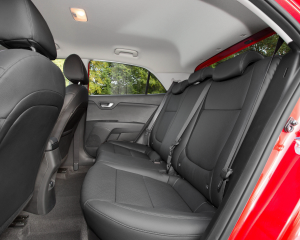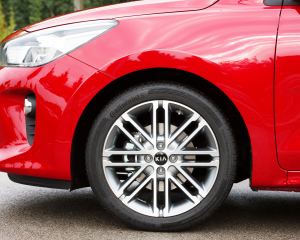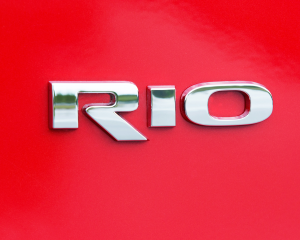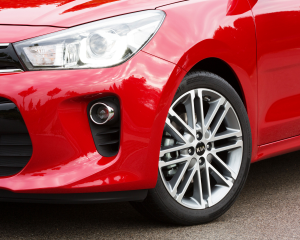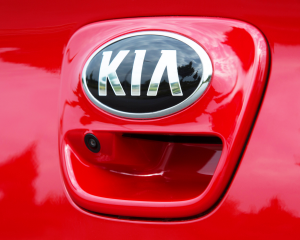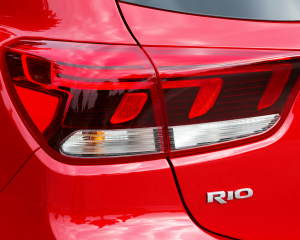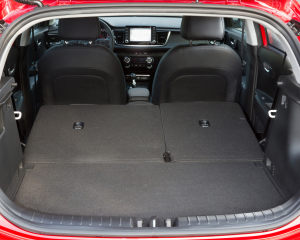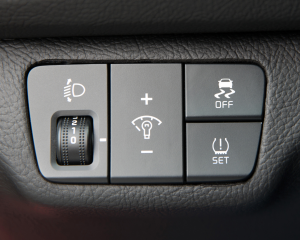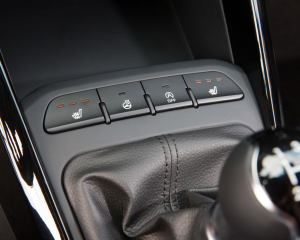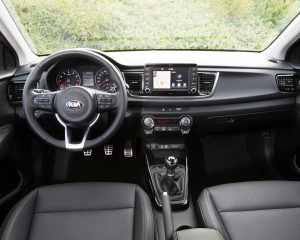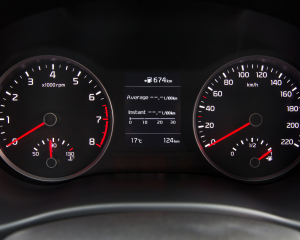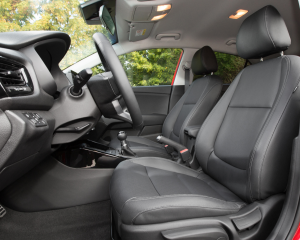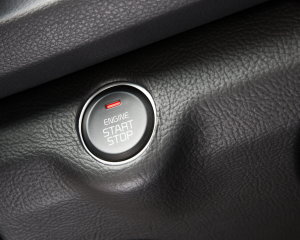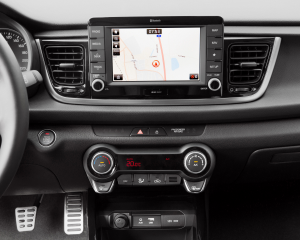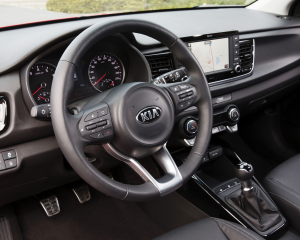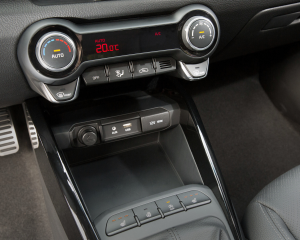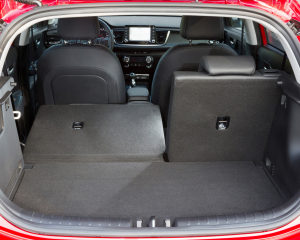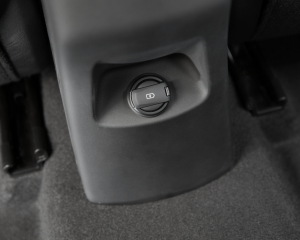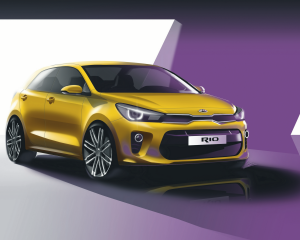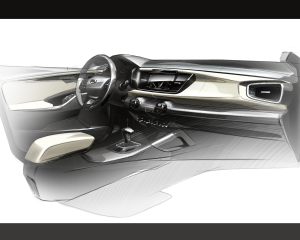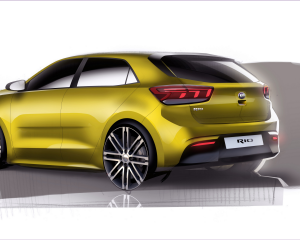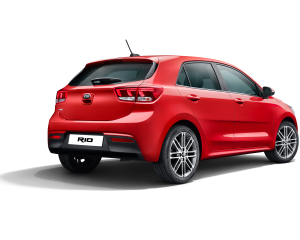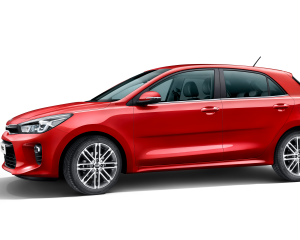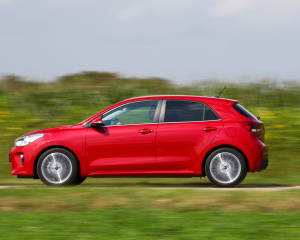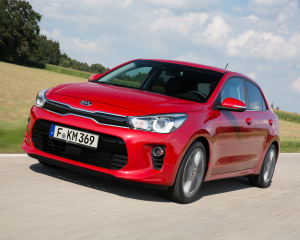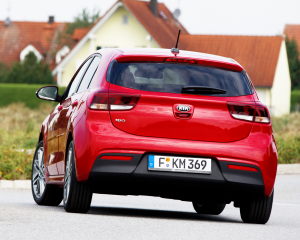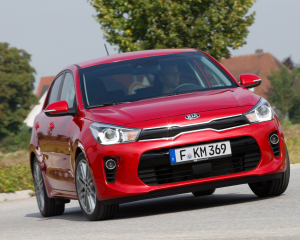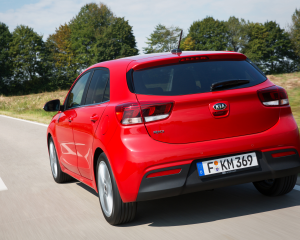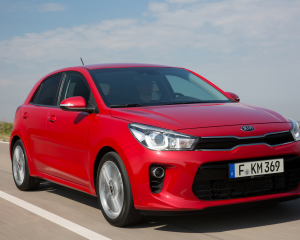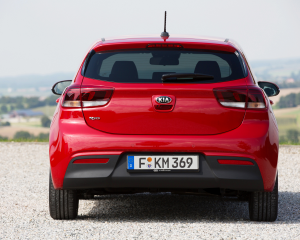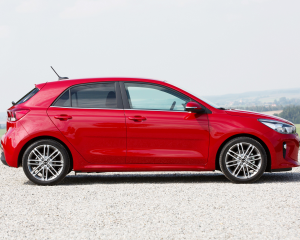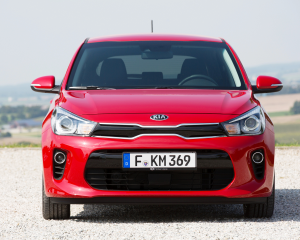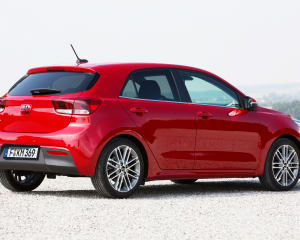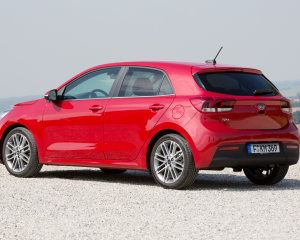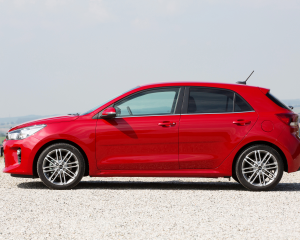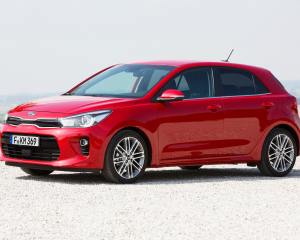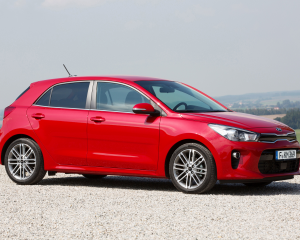Overview
ALL-NEW KIA RIO RAISES THE BAR FOR DESIGN, SPACE AND DYNAMICS
- Latest version of Kia’s popular B-segment model, one of the brand’s global best-sellers
- Progressive exterior design and modern cabin with ‘floating’ interface
- New in-car technologies and connectivity features, including Android and Apple smartphone integration
- High safety – the first car in class to offer Autonomous Emergency Braking with pedestrian recognition
- Engaging handling and more comfortable ride
- Class-leading cabin spaciousness and 325-litre cargo capacity
- Available with Kia’s lively new 1.0-litre T-GDI engine range
- On sale in Europe during the first quarter of 2017
The all-new Kia Rio will go on sale across Europe during the first quarter of 2017, following its world debut at the 2016 Mondial de l’Automobile in Paris. The B-segment car is the Korean manufacturer’s second best-selling model globally, with just under 450,000 units sold around the world in 2016, accounting for 15% of Kia’s annual sales.
Now in its fourth generation, the new Rio stands out thanks to its progressive design, class-leasing practicality and safety technologies, new connectivity features and more engaging ride and handling.
Michael Cole, Chief Operating Officer for Kia Motors Europe, commented: “The Rio is an important car for Kia, as one of our best-selling models worldwide and our third best-seller here in Europe. The B-segment is a hotly-contested area of the new car market, and the third-generation Rio helped introduce more people to the Kia brand than ever before.
“As a gateway to the brand, the Rio has offered an attractive design, low running costs and a practical nature. It’s for these reasons that the outgoing model has sold in record numbers around the world. The all-new Rio will build on these key strengths and increase its desirability, thanks to a more enjoyable drive and the most advanced safety features in its class.”
Designed and engineered to meet the needs and desires of a wider range of buyers, the new Rio will play an increasingly important role in the Kia model line-up. The B-segment is the largest segment in the European new car market, and Kia anticipates that full-year sales of the new Rio will place the car alongside Kia’s best-selling models in Europe, the Sportage and cee’d.
Exterior design: Defined by straight lines and smooth surfaces
The Rio’s progressive new exterior and interior design was led by Kia’s design centres in Germany and California, in close collaboration with the company’s domestic design base in Namyang, Korea. The appearance of the new Rio is defined by straight lines and smooth surfacing, giving the car a distinctive new look and more mature character than its predecessor.
At the front, the Rio wears the latest evolution of Kia’s ‘tiger-nose’ grille, now thinner in height and wider across the front of the car, with a gloss black grille mesh and surround. The grille is integrated with the newly-designed bi-function headlamps, more sculpted for a sharper look, and featuring a new U-shaped LED daytime running light signature. The Rio’s front fog lamp surrounds are moved outwards and upwards in the front bumper compared to their position on the third-generation model, adding greater visual width to the front of the car for a stronger overall look. The longer bonnet features bracket-shaped creases that run down from the base of the A-pillars to the grille and headlamps.
In profile, the fourth-generation Rio’s lengthened, more balanced stance is achieved with a long bonnet and longer front overhang, a 10 mm longer wheelbase (up to 2,580 mm), a thinner, more upright C-pillar, and a shorter rear overhang. Overall, the new car is 15 mm longer than its predecessor, at 4,065 mm in length, and 5 mm lower (now 1,450 mm tall). Straight, clearly-defined lines run down the full length of the car’s shoulder and along its doors, further stretching the appearance of the car for a more confident look.
The rear section of the Rio is now more upright, with a near-vertical rear windscreen. The straight line that runs from the grille, through the headlamps and along the top of the doors, continues around the back of the car, paired with thinner, more sculpted rear lamps, which now feature a new arrow-shaped LED light signature. Like the wider-looking ‘face’ of the car, the rear design of the new Rio gives the car a stronger overall appearance.
For European buyers, the new Rio is available in a choice of eight exterior colours and with three different aluminium alloy wheel designs, ranging from 15- to 17-inches in diameter. The Rio will be sold as a five-door model in Europe.
Interior design: Modern cabin with new floating HMI
The new Kia Rio features a modern new cabin, with sculptural forms and a more ergonomic layout than its predecessor. The interior has also been designed to accommodate the Rio’s new range of technologies.
Like the exterior, straight lines running the width of the dashboard characterise the shape of the interior, giving the cabin a wider appearance and increasing the sense of space for occupants. As well as long, lateral lines that govern the shape of the dashboard, horizontal vents further add to the visual width of the cabin, replacing the vertical vents of the third-generation model. Gloss black trim lines the central section of the dashboard.
The dashboard itself is now angled towards the driver, a layout which provides the car with a sportier, more driver-focused design and a more premium character. At the centre of the dashboard is a ‘floating’ HMI (human-machine interface), available with a high-resolution touchscreen. Below, the driver-oriented centre console features fewer buttons, with more ergonomic, concave switches and rotator dials below to control the heating and ventilation.
The new Rio is available with a choice of black or grey cloth seat upholstery, or with black or grey artificial leather. A ‘Red Pack’ for the Rio gives buyers black with red artificial leather-trimmed seats throughout the cabin.
New technologies further boost the appeal of the Rio’s cabin. Designed to improve comfort and convenience for owners, the new model is available with keyless entry and ignition, heated seats and steering wheel, rain-sensing windscreen wipers, and automatic headlamps. Buyers can also specify Automatic Cruise Control, with a speed limiter, and Rear Park Assist with a rear view camera (see ‘Safety’ for more information on the Rio’s new safety systems).
Careful thought has been given to improving the cabin’s isolation from wind, road and engine noise. New dashboard soundproofing materials have been adopted to reduce engine noise levels in the front of the cabin, while a stiffer front subframe minimises vibrations from poor road surfaces. Changes to the exterior further enhance interior refinement, with the fourth-generation Rio adopting new front wheel air deflectors, a full under-body cover and vertical ‘blades’ extending downwards from the boot spoiler, each serving to reduce wind noise and aerodynamics.
Practicality: Greater cabin and cargo space, with improved all-round visibility
Achieving high levels of practicality was a key focus for Kia’s development and engineering teams, and the result is a car with the most spacious cabin and one of the highest cargo capacities (325 litres) in the B-segment.
The Rio’s 10 mm-longer wheelbase and 15mm-longer body contribute to larger cabin and cargo area dimensions. Leg room grows to 1,070 mm in the front and 850 mm in the rear, while the new model offers more shoulder room than most other cars in its class – 1,375 mm in the front and 1,355 mm in the rear. Despite the new Rio being 5 mm shorter in height than the outgoing model, front and rear headroom (1,020 mm and 964 mm respectively) are among the best in the B-segment.
These improvements to space in the cabin have been achieved with a series of changes to the Rio’s packaging. These include re-profiled door trims, the adoption of new headlining materials, and changes to the shape of the dashboard, as well as more significant changes to the bodyshell of the Rio – such as the longer wheelbase.
Furthermore, thinner C-pillars – reduced in width by 87 mm – and relocated door mirrors (moved up to the base of the A-pillar) help minimise the size of the driver’s blind spots and improve all-round visibility. A lower window line around the cabin and new quarterlights at the tail end of the rear doors also give the driver and passengers a better view out.
The Rio’s cabin offers more storage space than before. At the base of the centre console is an open double tray to store mobile devices and other small items, and the overhead console includes an area to store sunglasses. The glove compartment is also a single-box shape. The new Rio has bottle holders in every door (to accommodate 1.5-litre bottles in the front and 0.5-litre bottles in the rear of the car) and two larger cupholders in the front. The doors also feature closed-bottom storage holes in the door handles, useful for small items such as a phone or coins. An optional armrest is available, adding further storage capacity to the cabin.
Luggage capacity is increased by 37 litres to 325 litres (VDA; +13%), among the best in class. This extra space has been achieved in spite of the Rio’s rear overhang being shortened by 15 mm to 655 mm, a key element of the car’s new design. The new Rio features a split-level boot floor, enabling owners to change its height to fit items under the floor to prevent them rolling around, or to keep them out of sight. The Rio is fitted as standard with split-folding rear seats and a tyre mobility kit under the boot floor. Buyers can specify an optional spare wheel.
The fuel tank, which is located under the rear bench, is 45 litres in size, two litres larger than the earlier model and providing up to 34 to 58 kilometres of additional range per tank, depending on engine (based on the NEDC combined combustion cycle).
Powertrains: Efficient new T-GDI engines with low emissions and instant responses
The new Kia Rio is powered by a range of gasoline and diesel engines, each offering high efficiency and willing acceleration.
All models fitted with a manual transmission are equipped with Kia’s Idle Stop & Go system as standard, with 100 ps 1.0-litre T-GDI and 77 ps 1.4-litre diesel engines available with an Eco Pack and a Low Fuel Consumption (LFC) Pack. The Eco Pack includes 15-inch wheels, LED daytime running lights and Michelin low rolling resistance tyres, and features slightly longer gear ratios for greater fuel efficiency. The LFC Pack is made up of the same features and modifications, and also includes a 5 mm reduction in ride height, to 135 mm. Low rolling resistance tyres are also available on certain other models to realise further reductions in CO2 (see technical spefications at end of document)
An increasing customer appetite for downsized, turbocharged engines has led to the adoption of Kia’s latest three-cylinder 1.0-litre T-GDI (turbo gasoline direct injection) engines. The lightweight and compact new engine was introduced for the first time in the upgraded Kia cee’d in 2015 and is expected to account for the majority of Rio sales.
As well as offering high efficiency and low emissions, the lightweight nature of the new T-GDI engines benefit the Rio’s keen front-end handling, with less mass and inertia for the car to work against under cornering. Customers ordering their Rio with the 1.0-litre T-GDI engine can choose between 100 or 120 ps power outputs.
The 100 ps engine produces peak power at 4,500 rpm and 172 Nm torque from 1,500 to 4,000 rpm. The lower-powered of the two T-GDI engines is capable of 4.5 L/100 km (4.3 L/100 km with the Eco Pack; 4.1 L/100 km with the LFC Pack), with CO2 rated from 102 g/km (99 g/km with Eco Pack; 94 g/km with LFC pack).
The higher-powered 120 ps engine produces the same torque output across the same band of engine speeds, while power is accessible at a higher 6,000 rpm peak. Fuel economy of 4.7 L/100 km results in CO2 emissions of 107 g/km.
Alongside the 1.0-litre T-GDI, the Kia Rio is offered with naturally-aspirated 1.25-litre and 1.4-litre MPI (multi-point injection) gasoline engines. The 84 ps 1.25-litre engine produces its peak power at 6,000 rpm and 122 Nm torque at 4,000 rpm, with 4.7 L/100 km economy and 106 g/km CO2 when equipped with low rolling resistance tyres (4.8 L/100 km and 109 g/km on standard tyres). The 1.4-litre produces 100 ps at 6,000 rpm and 133 Nm torque at 4,000 rpm, and is capable of 5.0 L/100 km fuel efficiency, with CO2 emissions of 114 g/km.
For even lower emissions, the new Rio will also be sold with a 1.4-litre diesel engine, producing either 77 or 90 ps. Regardless of power output, the 1.4-litre diesel engine will be capable of producing the lowest CO2 emissions levels and highest fuel efficiency in the Rio line-up. For the 77 ps model, emissions are as low as 88 g/km (with LFC pack; 92 g/km with the Eco Pack), while the 90 ps engine produces 96 g/km CO2.
All engines apply power to the front wheels, either through a five-speed manual transmission for 1.25-litre and 100 ps 1.0-litre T-GDI gasoline engines; or a six-speed manual transmission for the 1.4-litre gasoline engine, the higher-output 120 ps 1.0-litre T-GDI engine, and both 1.4-litre diesel engines.
Safety: ADAS assistive technologies and a five-star Euro NCAP target
The new Rio is one of the safest cars in its class, available with a package of Kia’s Advanced Driver Assistance Systems (ADAS). The new Rio is built on high-strength steel body and features a wide array of passive safety equipment – the car is engineered to meet the most demanding crash safety test criteria around the world.
Targeting a five-star Euro NCAP crash safety rating when fitted with optional ADAS technology, the Rio is the first car in the B-segment to feature Autonomous Emergency Braking (AEB) with pedestrian recognition. The Rio’s AEB system uses a long-range radar detection system to detect potential collisions with other vehicles or pedestrians and helps bring the car to a halt*. AEB is paired with a Lane Departure Warning System (LDWS), which alerts the driver if they stray out of their lane on the road without the use of indicators.
Towards the end of 2017, Kia plans to make an even wider range of safety assist technologies available to Rio buyers, including Blind Spot Detection, High Beam Assist and a new Driver Attention Warning (DAW) system. DAW monitors the driver for drowsiness or inattention based on sensors reading steering, acceleration and turn-in signal use. If it detects the driver isn’t paying close attention to the road, it sounds an alert through the speakers and in the instrument cluster.
The bodyshell of the new Rio is made up of a significant proportion of Advanced High Strength Steel (AHSS). The extensive use of AHSS in the body of the Rio is part of a wider effort by Kia to achieve a 5% reduction in the average weight of new car bodies by 2020 when compared to 2014, while achieving greater safety and security. 51% of the new Rio’s body is made out of strong, light AHSS, compared to 33% in the third-generation model.
The increased application of AHSS has strengthened the passenger cabin ‘cell’ for greater occupant safety and more effective distribution of impact forces. The stronger steel has been used to reinforce the A- and B-pillars, as well as side sills, roof structure, engine bay and floor pan.
The new Rio is fitted with six airbags throughout the cabin, as well as ISOFIX child-seat tether and anchor points for front and rear passenger seats.
Driving: More engaging and stable handling with a comfortable ride
As well as being incredibly safe to drive, the new Rio builds on the level of driver engagement offered by the third-generation model. Kia’s chassis development teams have sought to introduce greater driving appeal, with more agile handling and enhanced steering response. The Rio sits on fully-independent MacPherson strut front suspension and a torsion beam rear axle.
The development of a stiffer bodyshell also gave R&D teams the freedom to develop a more compliant suspension system. The new Rio benefits from a revised spring and damper set-up than the outgoing model, improving the car’s compliance and comfort at all speeds, while facilitating the car’s more enjoyable, engaging handling characteristics.
Compared to the third-generation model, Kia’s development teams have made wide-ranging modifications to the Rio’s chassis, endowing the car with more immediate handling responses and improving the level of confidence that the driver has behind the wheel.
A new front suspension system features more rigid struts and cross member, resulting in more direct, assured steering for more immediate handling responses. The rear shock absorbers are now mounted more vertically, with the new mounting position enhancing the ability of the rear axle to absorb shocks to improve ride comfort and stability under cornering and at speed. By repositioning the power steering gearbox, engineers have been able to reduces friction through the gears, enabling a 5% quicker steering ratio from ‘on-centre’ and more immediate steering responses.
On top of the new package of ADAS technologies, the new Rio is fitted as standard with Kia’s Vehicle Stability Management (VSM) with Electronic Stability Control (ESC). VSM ensures stability under braking and cornering, detecting a loss in traction and using ESC to help the driver keep the car on course.
Accompanying VSM and ESC are two new technologies, fitted as standard. The first of these, Cornering Brake Control, applies asymmetrical braking force to individual wheels when braking under cornering, counteracting a potential loss of traction for greater safety. In addition, Straight Line Stability eliminates yaw under hard straight-line braking – again, applying brake pressure adjustments to individual wheels to maintain stability during heavy braking or an emergency stop.
Connectivity: full Android and Apple smartphone integration
At the centre of the dashboard is the new infotainment system, housing Kia’s latest HMI (human-machine interface). The new Rio is available with a ‘floating’ 5.0-inch touchscreen audio system with six speakers. An optional 7.0-inch touchscreen infotainment and navigation system incorporates Kia Connected Services powered by TomTom®, as well as Android Auto™ and Apple CarPlay™ for full smartphone integration.
Accessed via the navigation system, Kia Connected Services connectivity package offers drivers a wide range of up-to-date information, including live traffic updates**, speed camera locations and alerts**, local point-of-interest search and weather forecasts. Kia’s Connected Services is available free-of-charge for European buyers for seven years after the car’s purchase.
The Rio’s Android Auto™ system is designed to work with Android phones running 5.0 (Lollipop) or higher. Available from launch, Android Auto™ connects to the user’s phone and lets them access smartphone apps and functions through the in-car infotainment system, such as voice-guided Google Maps navigation, hands-free calls and texts and voice recognition. Android Auto™ also lets users stream music from Google Play Music™ and other services.
Apple CarPlay™, for iPhone 5 or newer, enables full Siri voice control to manage the phone’s various functions and apps, including navigation via Apple Maps, calls and text dictation. Apple CarPlay™ also supports other audio apps that the user may have downloaded to their iPhone – such as music streaming or audiobook services.
By the end of 2017, the Rio will also be available with a full-connectivity 7.0-inch touchscreen audio-infotainment system, without navigation.
The Kia Rio is the first car in the B-segment to be equipped with USB ports in both the front and rear of the cabin, enabling users to physically connect a mobile device to the Rio’s infotainment system, and recharge batteries on the move.
On-sale: New Rio available in Europe in Q1 2017
The all-new Kia Rio will go on sale across Europe during the first quarter of 2017, with the company’s unique 7-Year, 150,000 km warranty as standard. The new Rio is manufactured at Kia’s Sohari manufacturing facility in Korea.
